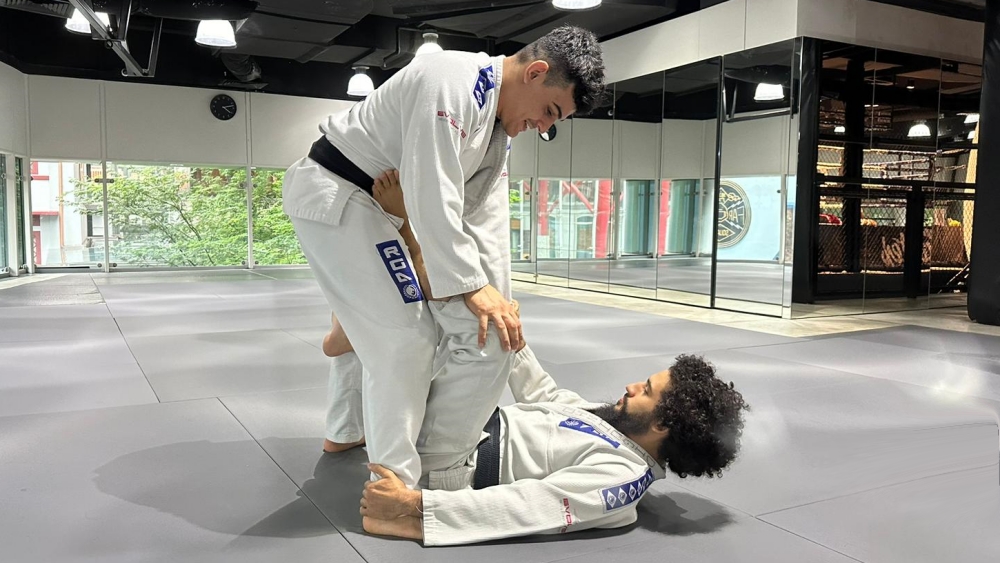Brazilian Jiu-Jitsu is a martial art famous for its elaborate techniques and continuous evolution. Among the myriad of techniques out there, the tripod sweep stands out as an essential tool in a Jiu-Jitsu practitioner’s arsenal. Known for its versatility and effectiveness, the tripod sweep is a technique that allows you to sweep the opponent from the guard position and secure a dominant position or submission opportunity. In this article, we dive into the secrets of the classic tripod sweep, exploring its mechanics, grips, and when to apply it during a match.
What Is The Tripod Sweep?
The tripod sweep is often one of the first sweeps taught to new Brazilian Jiu-Jitsu practitioners because it can be utilized from numerous guard positions. The tripod sweep is basically a sweep where you typically control the opponent’s legs as you use kuzushi (off-balancing) to force them to the mat. There are several variations of the tripod sweep in BJJ, but the fundamental definition of gripping the opponent’s legs as you off-balance them remains the same.
What makes the tripod sweep such an effective move is its simplicity. Once the opponent stands up, they are immediately vulnerable to tripod sweeps, provided that you get the proper grips and body positioning. It is also a technique that is applicable in all forms of grappling, including mixed martial arts (MMA). Let’s now look at the technique and its variations.
8 Tripod Sweeps That You Should Know
Professor Gustavo Gasperin is a respected BJJ blackbelt with a wealth of knowledge in the sport. He shares 8 variations of the tripod sweeps that he considers essential for grapplers of all levels.
The first technique is the tripod sweep from the basic open guard. As soon as your opponent stands up to escape your closed guard, you can sweep them over by cupping their ankles as you use your hips and legs to push them backward. This is the simplest form of the tripod sweep and is usually taught in the first months of training.
The second technique is the tripod sweep, but you place your feet on the opponent’s hips. This is a useful alternative if you cannot keep your legs wrapped around their hips. The mechanics are still the same, all things considered.
The third technique is the tripod sweep if your opponent has a staggered stance. Use your hand and grab the foot that’s closest to you as you hook their far leg with your shoelaces. Place your other leg across their hip and push to sweep them over.
The fourth technique is the sickle sweep from the open guard. It is essentially like the previous technique, but the placement of your legs is in reverse (you place your right foot near the hip and your left leg on the opponent’s same side leg. The main difference with this variation is that you make a push-pull motion with your legs instead of pushing them over for the sweep.
The fifth technique is the infamous dummy sweep or double kouchi, made famous by Marcelo Garcia and Gordon Ryan. This is an easy technique where you place your shoelaces behind the opponent’s ankles as you push their knees or hips. It is an excellent technique and has practically no downsides.
The sixth technique is the tripod sweep from the single-leg X (SLX) guard. First, enter the single-leg X position however you want (Gustavo demonstrates the shin-to-shin entry). Once you establish the single-leg X guard, grab both ankles and push with your hips to complete the sweep.
The seventh technique is the tripod sweep from the overhook/modified X guard. If the opponent pushes your outside foot in the SLX guard, transition to the overhook X by forming an “X” shape with your legs while keeping your grip on their foot. From here, place one foot near the hip and the other on the ankle and sweep them over.
The last technique is the tripod sweep (wrestle-up variation) from the shin to the shin guard. Lift the opponent’s leg with your hook, grab the far leg, and take them down with a double leg-style finish. Many of today’s competitors gravitate to wrestle-ups to attack from the guard. This technique is a good introduction to wrestle-ups and applies to practitioners of all skill levels.
Tips And Recommendations
Understand that the tripod sweep is a technique that requires timing and good positional understanding to work. Since a big part of the sweep involves grabbing the opponent’s feet, you must do your best to generate power using your hips to sweep them over. Not generating enough power may lead to eventual guard passes from your opponent. Using misdirection can also help with your tripod sweeps. Stay dynamic on the bottom and be open to switching your grips (even configuration) depending on the opponent’s body placement and weight distribution. The tripod sweep is meant to be done in transition, so movement is a key ingredient to its success.
Process Of Repetition
Practicing the tripod sweep is an absolute must because it relies so much on sensitivity and displacement of weight. Please find the time to practice these sweeps, from entries to the actual sweep. All of the steps in the tripod sweep require a solid grasp of positional understanding and should be studied diligently. Note that this is not a brute move; you need to use your whole body as a unit to properly execute the sweep. Drill these sweeps until you master every step.
Conclusion
The BJJ Tripod Sweep is a versatile and effective technique that can catch your opponent off guard and lead to dominant positions or submissions. By mastering the tripod sweep’s mechanics, variations, and timing, you can add another valuable tool to your BJJ arsenal. Remember that, like any technique, consistent practice and adaptation to your opponent’s reactions are crucial to success. So, hit the mats, drill, spar, and unlock the secrets of this powerful sweep.
You may also like:

















